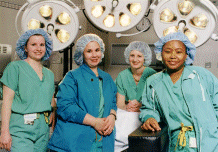 Spine Surgery
Spine Surgery
Introduction to Spine Disease:
The Comprehensive Spine Care Service
|
A specially trained team of registered nurses staff the dedicated, state-of-the-art operating rooms. Complete and Accurate Diagnosis |
The treatment of spine disorders at the Neurology and Neurosurgical Services utilizes the most modern concepts of both diagnosis and treatment. Patients are evaluated to distinguish those who will benefit most from conservative therapy from those who will require surgery. The best test currently available is Magnetic Resonance Imaging (MRI) which is performed early and in most instances results in a complete, accurate diagnosis. CT/myelogram, commonly used in the past, is now rarely used due to the superiority of the MRI. The sophisticated MRI computer software available at Cooperman Barnabas for the investigation of spine disease alleviates the pain and discomfort previously experienced with CT/myelogram.
Conservative Treatment at the Pain Institute
If conservative therapy is indicated, the patient is referred to the Pain Institute where a team of physiatrists, anesthesiologists, physical therapists and specially trained nurses develop a plan of treatment best suited to the specific needs of the patient. The available modalities include medications of various types and combinations to control the pain and inflammation until the body heals itself, minor procedures such as pain stimulators, cryosurgery, facet blocks, epidural and foraminal injections, trigger point injections and others as well as standard physical therapy, aquatherapy and acupuncture.
Spine Surgery
If surgery is required, the treatment is tailored to the individual patient's needs by utilizing modern diagnostic techniques and innovative surgical technology with the goal of providing effective treatment with the least risk. Surgery is performed by experienced neurosurgeons and is based entirely in microsurgery.
Among the types of procedures utilized is a minimally invasive microsurgical discectomy in which the disc herniation and the relief of nerve compression is achieved under direct vision through an incision which is less that 2 inches on the average. Patients are usually discharged within 24 to 48 hours and can generally return to work quickly. In the last 15 years, using modification of microdiscectomy developed by a leading member of our neurosurgical team, more than 500 patients have been treated with very satisfactory results that compare favorably with published national results.
At the Center for Complex Spine Surgery headed by Dr. Koziol, extensive spine reconstructions including replacement of vertebral bodies and stabilization through minimally invasive approaches are performed on patients with cancer as well as degenerative spine disease. Patients who receive cervical spine surgery are usually discharged within 24 to 48 hours after surgery. Pain from the bone graft donor site is eliminated by using Bank bone and special metal plates to promote better healing are used if necessary.
Other conditions such as spinal stenosis, in which the nerves are compressed by overgrown bone and ligaments, and which usually occurs in older patients, are treated with removal of the bone and ligaments compressing the nerves. While the surgical incision is usually larger as many vertebrae are involved, microsurgical techniques are also used. The modern technology used to limit operating time and blood loss eliminate the need for blood transfusions, even with extensive surgery.
Specialized Care Following Spine Surgery
Following surgery, patients usually go to a medium intensity care "step down" unit, particularly those who may have associated medical conditions such as high blood pressure or heart disease. Medical hospitalists are available around the clock to supplement neurosurgical care and for consultation in addition to the cardiac and respiratory consultants who monitor patients and prevent possible complications. An entire unit dedicated to the care of patients with neurosurgical and orthopedic conditions is staffed by a compassionate team of nurses specially trained in the care of these patients.
At the Forefront of Spine Reconstruction
In addition to routine spine, lumbar and cervical procedures, the most complex spine surgical procedures are also performed at the Institute for patients who would not benefit from other procedures. Among those is the placement of metal cages filled with bone (BAK cages) which is performed through an abdominal incision to replace a degenerated disc, or the placement of rods, screws and bone fusion in patients where the pain originates from abnormal motion between the vertebrae.
\In some instances, including those due to tumors that spread into the spine, both procedures are performed at the same time and one or several vertebrae are replaced. Operative time is shortened by teams of surgeons skilled in different techniques working simultaneously to provide the best results possible. Spine reconstruction is led by a neurosurgeon who possess special expertise in this complex technique and is at the forefront of developing new technology for spine reconstruction. Following surgery, patients are referred to an integrated rehabilitation program to allow early return to work.



